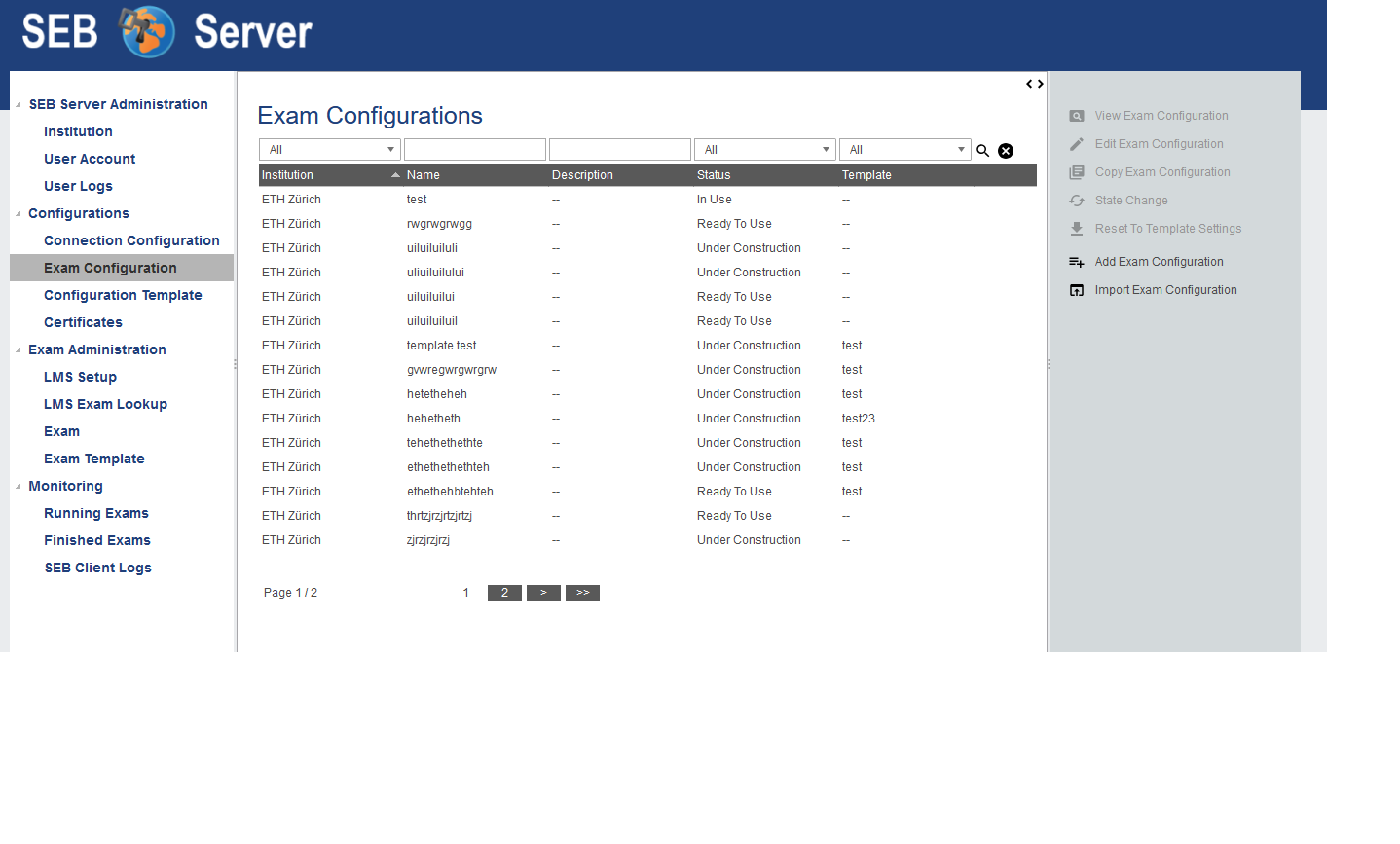Overview
Safe Exam Browser Server (SEB Server) is a web-service application with the objective to help set up and maintain e-assessments with Safe Exam Browser (SEB) in a centralized and more efficient manner. The SEB Server application can be used by an institution or organization as a self-maintained, lightweight server application to organize and set up their e-assessments. For an organization or institution that wants to provide safe e-assessments with Safe Exam Browser, SEB Server can help to organize these e-assessments more effectively, safely, and in one place. Furthermore, SEB Server can be set up and run within a cloud infrastructure by a general service provider to offer e-assessments with SEB and SEB Server as a service.
SEB Server comes with a built-in multi-tenancy functionality that allows to create and maintain institutions that are separated from each other. This is most convenient for smaller groups of organizations or institutions that want to have one self-maintained SEB Server instance but need internal separation of institutions.
Since SEB Server is generally an administration tool, meaning used to do administration work and tasks to set up and maintain e-assessments, there is yet just a built-in and lightweight user-account management where users can register themselves and get needed privileges assigned by already registered administrator users that has the privileges to maintain user accounts. Currently, there is no possibility to register with a third-party account and/or single sign-on.
SEB Server is written mainly in Java and uses Docker for installation and setup. For more information about the architecture and installation, please go to SEB Server Installation Guide
The key features of SEB Server are:
Built-in multi-tenancy capabilities. Create and manage institutions as separated clients.
Lightweight user-account management where users can register themselves and get needed privileges assigned by already registered administrator users that has the privileges to maintain user accounts.
Track user activities within user-activity logs for the whole SEB Server or a client.
Create, export, and maintain SEB connection configurations. Those are needed to startup a Safe Exam Browser client with and contain all information to connect securely to the SEB Server.
Create and maintain SEB exam configurations. Those are sent to a SEB client on connection setup and contain all SEB settings for a particular e-assessment.
Setup and maintain Learning Management Systems (LMS/Assessment Tool) and e-assessment systems like Open edX, Moodle, OpenOlat or ANS to be able to navigate and find courses or quizzes on the system and to push access restrictions to it if supported by the particular LMS/Assessment Tool.
Import and maintain courses or quizzes from an LMS/Assessment Tool. Setup everything that is needed for an e-assessment that is based on a course or quiz from the LMS/Assessment Tool
Apply indicators to the exams to indicate incidences while monitoring running e-assessments.
Monitor running e-assessment and have an overview of all connected SEB clients. Manage SEB client connections and view logs sent by individual SEB clients.
Roles and Use-Cases
The SEB Server supports a simple role-based privilege system where a role has read, modify and write privileges on certain domain entities. The privileges for a role are pre-defined and cannot be changed by a user. But roles can be combined for a user account. A user account for example can have the “Exam Administrator” and the “Exam Supporter” roles active to be able to set up and support an exam (e-assessment) within one user account.
Privileges for domain objects are categorized in read, modify, and write rights. Write right includes creation and deletion grants, as well as activation grants, in addition to the more restricted modify right that only allows modifying already created entities. They are also categorized into overall, institutional, and owner privileges where overall means for all entities, over all available institutions and institutional means only the entities that belong to the own institution whereas owner-privilege means the creator or assigned owner of an entity.
There currently exist four different roles. This reflects a good separation of concern within the SEB Server application administration itself and the setup and maintenance work that has to be done for e-assessments with SEB. Below are the names and a short description of each role.
SEB Server Administrator
This role is primarily to administer the SEB Server application, to create new and maintain available institutions and user accounts. In addition to that, a SEB Server administrator also has overall read privileges for most domains to be able to analyze problems and help others to solve them.
A typical use-case for a SEB Server administrator would be to create a new institution and an institutional administrator for this institution. Another use-case would be to maintain registered user accounts and to give more privileges. Or to entirely deactivate an existing user account.
Institutional Administrator
An institutional administrator has overall read access for its institution and can modify the institution properties as well as create new or maintain existing user accounts for the belonging institution. Furthermore, an institutional administrator can create and maintain learning management system (LMS/Assessment Tool) setups and SEB connection configurations for the belonging institution.
A typical use-case for an institutional administrator would be to give the appropriate roles and privileges to newly registered users of the institution. Or another use-case would be to create and maintain SEB connection configurations for the institutions and set up and maintain learning management systems within the SEB Server and the belonging institution.
Exam Administrator
With this role, a user can prepare an exam for an e-assessment with SEB. An exam administrator can view all courses from all learning management systems that are set up for the belonging institution and find a particular course to import this course as an exam within SEB Server. This role is also able to create and maintain SEB exam configurations that can then be assigned to an imported exam. After setting importing an exam, the role can set up all aspects of an exam like automated restrictions, allowed supporters and monitoring indicators, to name a few, and prepare the exam for an e-assessment.
A typical use-case for an exam administrator would be to create a SEB exam configuration within the templating and configuration section. Then to find a particular course or quiz from the learning management systems that is defined within the institution. This course or quiz can then be imported by the administrator as an exam. After import an exam administrator can prepare this exam for run and monitoring by attaching an exam configuration to it, preparing indicators to monitor incidences, and specifying the SEB access-restriction conditions for the course or quiz.
Exam Supporter
This role is to support a running exam within SEB Server. An exam supporter can see the running exams on that he/she has an assignment and can open them either for monitoring or editing some exam attributes during the exam.
A typical use-case for an exam supporter when an exam is running would be to overview the connecting SEB clients and manage them. While SEB Server shows incidences or irregularities, an exam supporter can act on them and take the appropriate actions if needed.
Sign Up / Sign In
What one will see first when applying to a SEB Server application is the login-screen

If you are already registered you can use your username and password to log in. Or use the “Register” button to go to the registration page to create a new user account. The newly created user account will only have the Exam Supporter role assigned. If you need another role or more privileges, this must be given and granted by an institutional administrator of the belonging institution.

Fill in the registration form and create a new account. After the user account has been successfully created, the application redirects to the login page for login. On the current version, an e-mail confirmation is not a feature of the SEB Server application and therefore the e-mail address is currently just informative.
With the “Time Zone”, you can choose a specific time zone for your user account. All dates and times will then be shown within this time zone.
Graphical User Interface
After successful login, you will see the main graphical user interface of the SEB Server application. On the left hand are the activities that can be done, categorized within a few main sections with their relating activities underneath. By selecting an activity, the main content section will show the activity content and the action that are possible for this activity on the right-hand side.

In the header above on the right hand, we see the username of the currently logged-in user and an action button to sign out and go back to the login page.
The main content usually consists of a list or a form.
Lists
A list shows all the objects of a particular activity on a table page. A list has paging functionality and the list has more objects than fitting all on one page, a page navigation is shown at the bottom of the list with the information of the current page and the number of pages along with the page navigation that can be used to navigate forward and backward thought the list pages.
Almost all lists can filter the content by certain column filters that are right above the corresponding columns. You can use the column filter input to filter the list and narrow down a specific collection of content. Accordingly to the value type of the column, there are different types of filters:
Selection, to select one instance of a defined collection of values (drop-down).
Text input, to write some text that a value must contain.
Date selection, to select a from-date from a date-picker. A date selection can also have an additional time selection within a separate input field
Date range selection, to select a from- and a to-date within different inputs and a date-picker. A date range selection can also have an additional time range selection within separate input fields
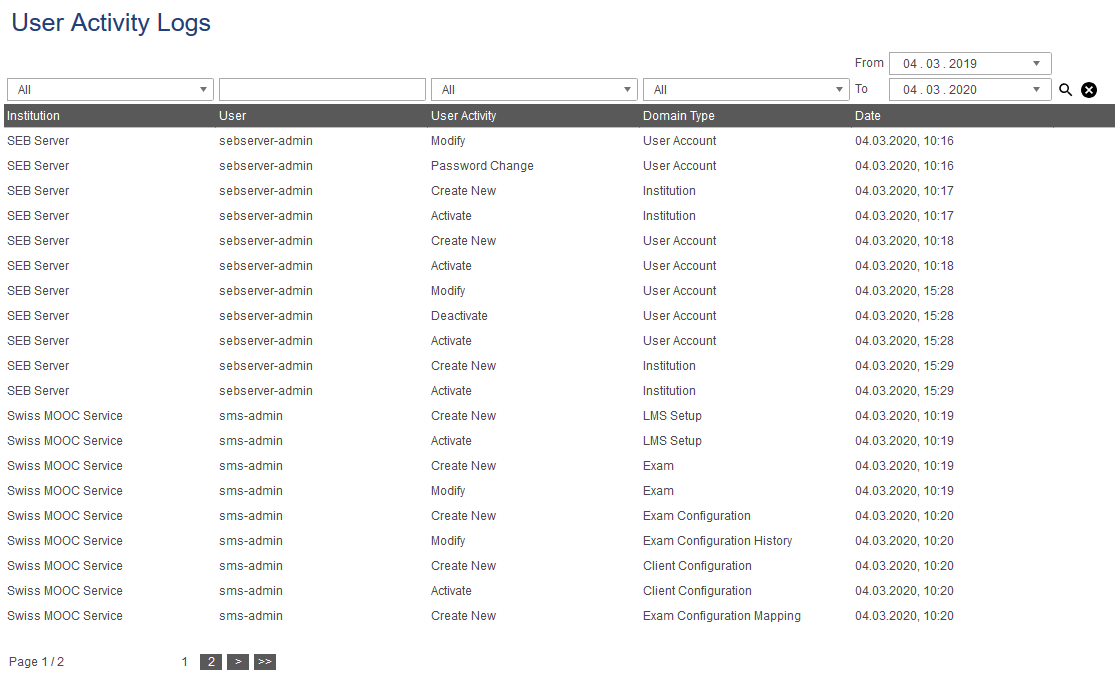
A list can be sorted within a column by clicking on the column header. The order of sorting can be changed by clicking again on the same column header of the sorted column. If sorting functionality is available for a column depends on the column type. There are a few columns that do not have a sort functionality yet. Most columns have a short tooltip description that pops up while the mouse pointer stays over the column header for a moment. A column tooltip usually also explains how to use the column-related filter.
List Multi-Selection
Since SEB Server version 1.4, multi-selection for some lists with bulk-actions is possible. To select multiple rows in a table that allows multi-selection just click on the row as usual. If you then click on another (still not selected) row, this row get selected too. You can do this even over several pages. To deselect a selected row just click it again then it will be removed from the selection.
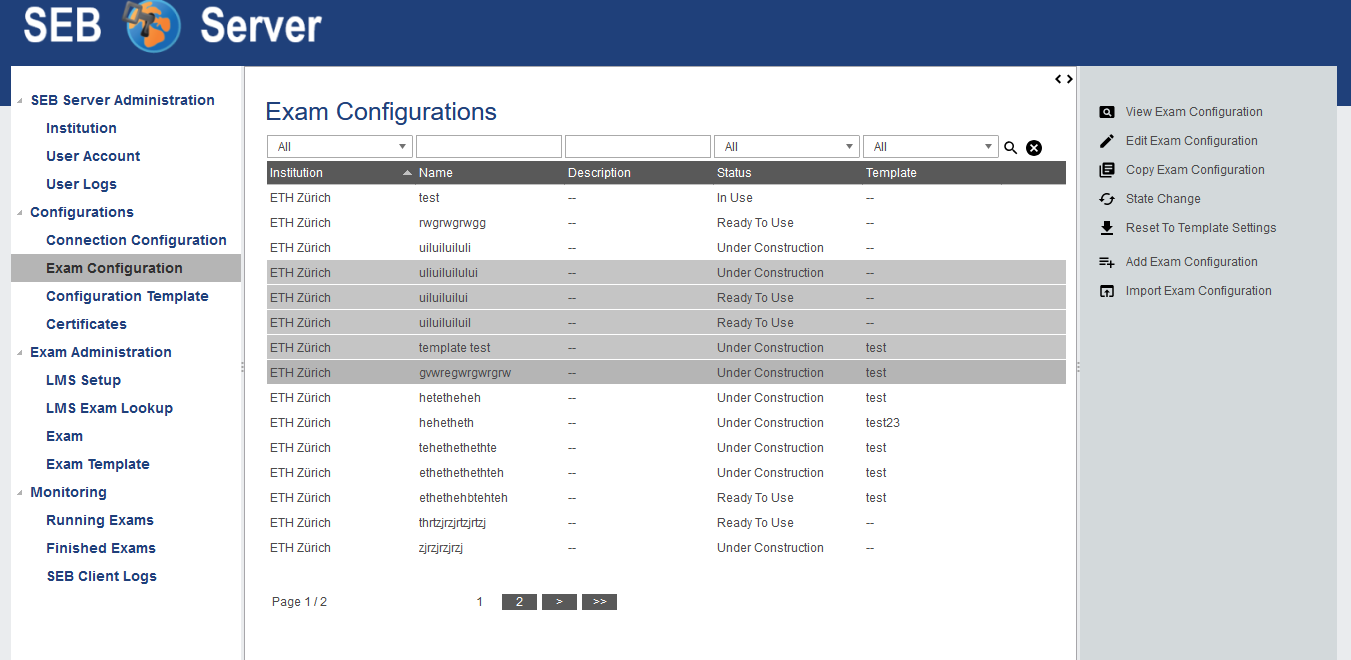
Note
Some actions on the right action pane are used only for single objects but also enabled on multi-selection. If you have multiple selections and use a single object action like “View”, “Edit” or “Copy” for example, then the system will take the fist selected object/row to work with.
Forms
Forms are used for domain entity-specific data input or presentation like HTML Forms usually do. Forms appear in three different ways within the SEB Server GUI:
When a domain entity is first created in edit mode
When a domain entity is modified also in edit mode
And when a domain entity is just shown, in read-only mode
The following images show the same form, once in read-only mode and once in edit mode
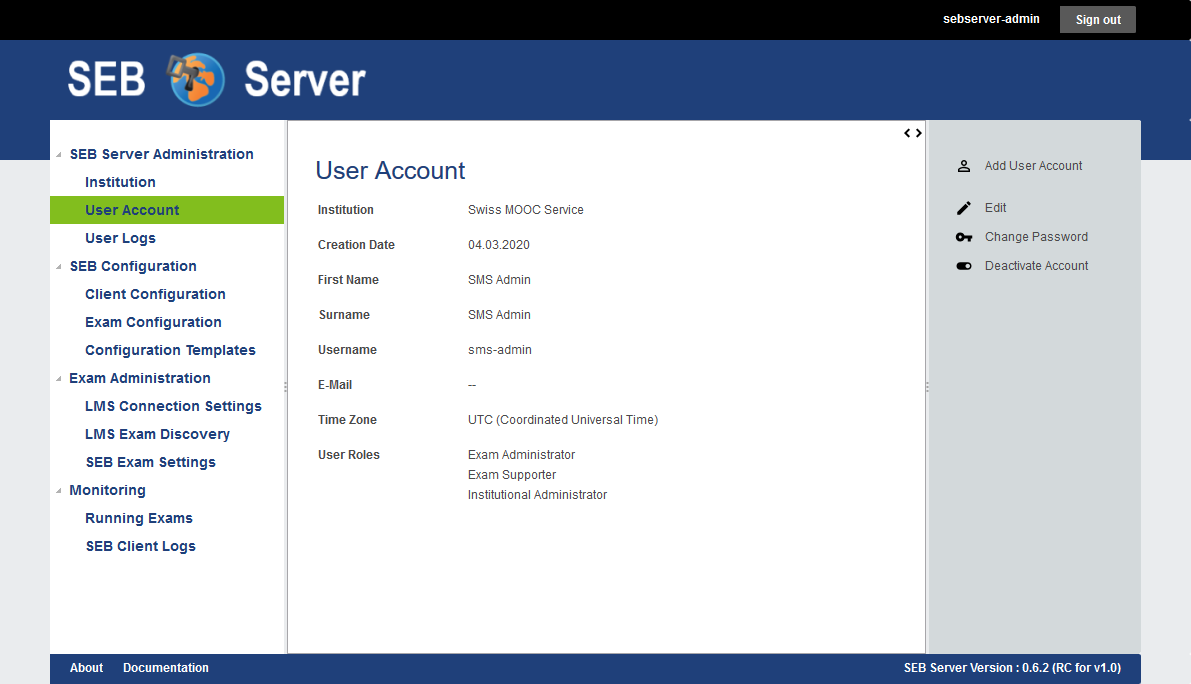
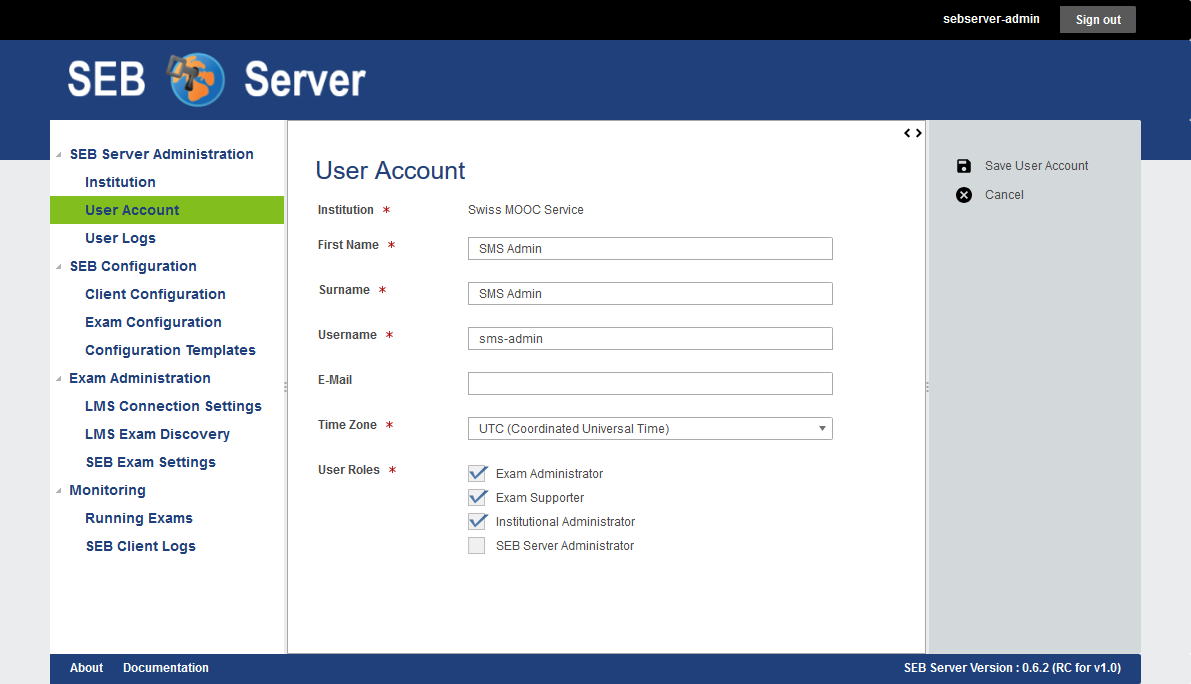
There usually is a tooltip on a form field element for almost all attributes that can be activated by either going over and staying on the form field label or the input section. If a form field is mandatory to either create or save an entity, this is marked with a little red arrow just to the right of the form field label. There may also be more field validation taking place on saving the object. If an input needs a special form that is not given by the current input, the form field will be marked with a red border around the input field and a thin red explanation text is shown right below the input field. After correcting the missing or wrong input and saving the form again, the SEB Server will accept and process the changes.
Note
If you navigate away from a form in edit mode, the GUI will inform you about possible data loss on this action and will prompt you to proceed or abort the action.
Actions
Actions are usually placed on the right action pane of the application and belongs to the actual site or view. There are generally three types of actions:
Form Actions that directly belongs to the actual view or object and either save, manipulate or create a new object.
List Action - Single Selection are actions on a list page that effects the selected list entry.
List Action - Multi Selection are actions that refer to the current multi selection on a list and apply for every selected item.
Note
List action are disabled when nothing is selected from the list and get enabled as soon as one or more list items are selected. Actions that are considered single selection actions, and are used with a multi selection on the list will only affect the first selected item in the list.
